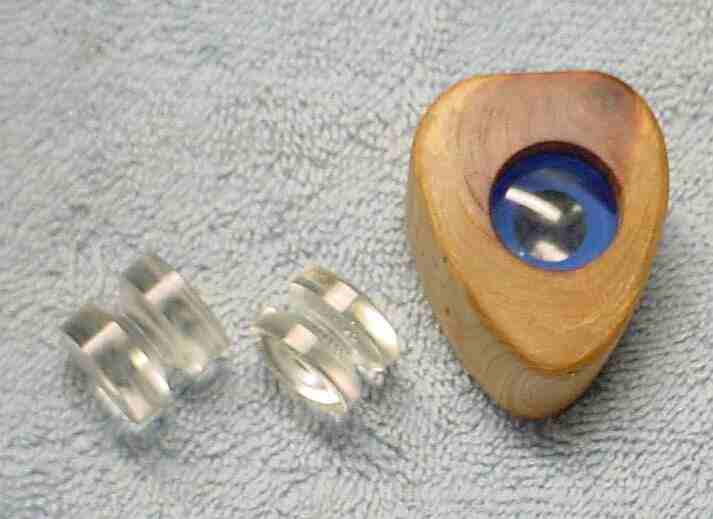
* GadgetBuilder.com *
Last Modified:

As a deer tick watcher I need a good 10x magnifier in order to count the legs (important in determining whether the tick could carry Lyme disease, a real concern here in CT). So, I bought a B & L Coddington type 10x magnifier. This works very well although it is heavier than the old no-name Hastings triplet 10x I've had for many years.
Impressed with the performance of the Coddington, I researched it on the net and found that it is an old design from the 1700's. The lens is a single piece of glass, thicker than a typical lens (i.e. it's a short cylinder), with a deep groove at the equator. Most single lens magnifiers are limited to 5x or so before significant distortion occurs, where the Coddington can provide up to 15x. The drawback to this design is that the diaphragm groove reduces the area seen through the magnifier so a larger lens is necessary for the same view field as a triplet; this large, thick lens makes the Coddington much heavier than a triplet with an equivalent field.
Once I understood the concept it seemed interesting to attempt a Coddington magnifier from Lucite rod. My goal was to make the Coddington weigh less, plus determine whether I could actually make a functioning high power magnifier with no knowledge of optics. As a basis for my Lucite lens I simply copied the B & L lens as best I could by eye ;-).
In order to make the spherical surface on each end of the Coddington I wanted to use my minilathe's ball fixture. This required a holder for the 3/4" Lucite, the raw material for the lens; I built a simple holder which is like a special collet held in the 3 jaw chuck. The fixture and the closer nut each have tapers toward the nose and are threaded right through the tapered section; this compresses the fixture as the nut is tightened. This holder has sufficient overhang to allow access to the lens surface with the ball cutter; simply putting the Lucite in the 3 jaw wouldn't work because the ball fixture would conflict with the chuck. The ball cutter was set for a 3/4" radius.
Shown at the top of this page is the machining progression: a blank with the groove cut, lens after polishing, lens mounted in a cedar holder. The heart shape and use of heartwood is a little humor: this was a labor of love because it took so long to make the holder and then to figure out how to polish the surfaces that it certainly wasn't a rational way to get a magnifier. I painted the groove blue to make the lens look like an eye. So, now I've got plenty of magnifiers.
The Coddington design seems very forgiving; the ones I made work similar to the B & L although the power seems slightly higher, perhaps 12x -- I don't know how this is measured so I can't say for sure. The focus is good and there are no obvious color fringes. Counting legs on deer ticks is easily done with it so I achieved at least part of my original goal. The weight of the wood holder makes my Coddington weigh almost as much as the B & L so perhaps I'll make a small holder from nylon or Delrin and add lens protection similar to the commercial versions -- no rest for the weary...
Update: I made several more Coddingtons as Christmas gifts -- in Connecticut everyone should have one for deer tick examination. The bronze version on the left (heavy) is from an old bearing, the wood is cedar where the varnish didn't stick well in places due to oil in the wood. The folding version provides protection for carrying in one's pocket; I added some decor to the aluminum, sort of a tern plate look. On the right is a folding version still under construction.
Lucite is awkward to work on my lathe because it is a thermoplastic, meaning it softens from the heat generated by cutting. Consequently, machining of the lens surfaces and the equatorial groove must be done slowly. More info about making optics from Lucite. It takes about a half hour to make a lens with this technique and tooling.
Lucite lenses are not limited to Coddingtons , e.g. the optical center punch and the drill sharpener alignment optic are made from 1/2" Lucite and work out very well.
This page was last modified
by John Moran, HTML tweaker. If you have a comment on this site or its contents,
click here.